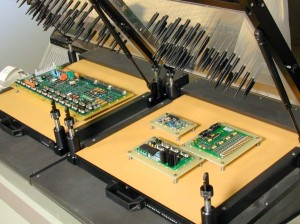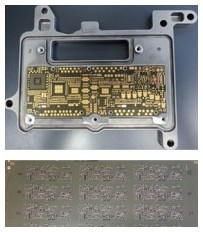PCB ELECTRICAL TEST

The PCB manufacturing process includes a final electrical test to verify net continuity and the absence of shorts on the board. In some markets, the increased complexity and variety of PCBs, along with decreasing volumes, have determined an extensive use of flying probe type test systems for electrical test. Seica solutions: Rapid Line
Electric Test on PCB with active embedded components
Today it is increasingly common to find in the printed circuit industry, PCB, featuring “embedded” components, either active or passive.The peculiarity of this product consists in the presence of embedded passive components (like resistences) and active embedded components, like voltage dividers. In order to optimize the production process, board panels are manufactured, containing multiple PCBs. On each PCB, a complete test should be performed for open, shorts, and also to check that the embedded components have the expected values (for resistances and voltage dividers).
active or passive.The peculiarity of this product consists in the presence of embedded passive components (like resistences) and active embedded components, like voltage dividers. In order to optimize the production process, board panels are manufactured, containing multiple PCBs. On each PCB, a complete test should be performed for open, shorts, and also to check that the embedded components have the expected values (for resistances and voltage dividers).
Each PCB within the panel, will have its own “electric” barcode, which should be read and stored to achieve a full data traceability. For reduced handling times, the panels are tested automatically.
The winning solution offered by Seica is the Rapid270 test system
Realization:
.Vertical architecture, with automatic “stretch” of the panel
.Automatic panel loading/unloading module
.Automatic and complete test program creation
. o Open/Short test
o Passive and active components
o Electric barcode reading
o Data storage for traceability
o External BOM import capability
Benefits:
.Unique test program
.Reduced program set-up times
.Panel test of the product instead of single item test
.Test time reduction
.Reduced risks of product damages arising from handling
.Full product traceability
PRODUCTS
- VIP Platform
- Flying Probe For Testing Probe Cards
- FLYING PROBE TEST
- Pilot VX
- Pilot VX XL HR for testing probe cards
- Pilot V8
- Pilot H4
- INNOVATIVE TEST SOLUTIONS FOR EV SECTOR
- PILOT BT FOR EV BATTERY TEST
- Pilot BTV for EV Battery Test
- Pilot BTP for EV Battery Test
- COMPACT BMS – BATTERY CELL SIMULATORS
- reverse-engineering
- Legacy Replacement -VALID LR
- IN-CIRCUIT AND FUNCTIONAL
- BARE BORD TESTERS
- Functional Systems
- INSTRUMENTS & MINI ATE
- ISP-DeviceClip
- LASER SELECTIVE SOLDERING
- OPTICAL INSPECTION (AOI)
- Automation
- INDUSTRIAL MONITORING
- Testing Service


